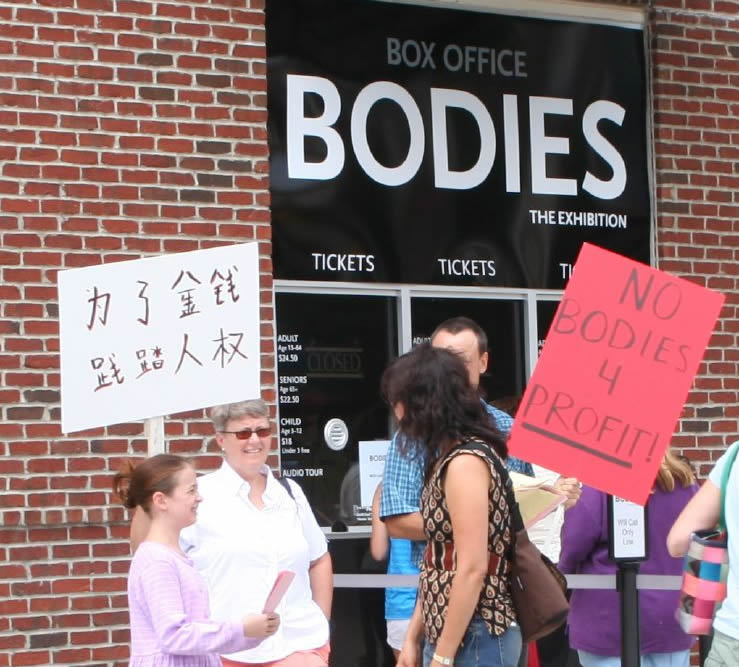Instructive Commodities: The Rhetorical Regulation of American Health and Gender Norms in Bodies…The Exhibition
In the Introduction to The Megarhetorics of Global Development, Rebecca Dingo and J. Blake Scott argue for scholars’ “need to mobilize rhetoric’s interpretive and productive toolbox” to “highlight, critique, and intervene in the hegemonic functions of neoliberal global development.” Furthermore, they call on rhetoricians to “expand and thicken the rhetorical clusters of this scholarly network [rather than accepting] rhetoric’s contributions to development [studies] and transnational studies as too diffuse to have critical and productive force” (16). This essay takes up their charge and examines how the term “regulation” is deployed within a peculiar transnational context. Specifically, I examine how this term courses through the show Bodies…The Exhibition and, in doing so, I “examine how rhetorics travel” and how they “become networked with new or different arguments” (my emphasis Dingo 5). I take up Rebecca Dingo’s metaphor of “network” to understand how the pedagogical arguments within Bodies…The Exhibition are made possible by a series of geopolitical relationships and how the power of those claims is maintained by a transnational economy in which human remains become commodities that are reclassified, transported, and reconfigured as instructive texts. Ultimately, this essay examines how regulation and commodification are networked—how these terms are discursively and materially connected to one another, how they influence each other’s meanings, and how their connections are deployed differently in response to particular circumstances and intended effects. My analysis illustrates how this kind of relationship can produce a site where not only do we see a neoliberal and gendered rhetoric inscribed upon third world bodies, but we also see where those bodies become metaphors for the current realities of geopolitical commerce.
Bodies…The Exhibition is a for-profit endeavor created by Premier Exhibitions, a widely successful United States company. Since the first installation opened in 2005, it has been seen by more than 15 million people across the world. The exhibit, which posits itself as a kind of “everyday anatomy course,”1 takes preserved human bodies that have been transformed via plastination and displays them to reveal their underlying structures. Typically situated in tourist locales, the exhibit conjures a sense of reverence and cultural importance with its museum-like atmosphere: the plastinated corpses are posed and labeled, they are purposefully lit, and staged dramatically. There are backlit displays of blood vessels and suspended organs, bodies sliced and splayed to reveal the skeletal system and musculature, and healthy organs juxtaposed with diseased ones.
Unlike the first plastination exhibit by Gunther von Hagens,2 Bodies…The Exhibition obtains most of its cadavers from the People’s Republic of China whose origins are not always assiduously documented.3 This detail is relevant for its obvious ethical concerns and for the way it highlights the political and global relationship that allows such a transaction to take place—how the economic and pedagogical elements of the exhibit are materially and epistemologically dependent upon the relationship between the “so-called” first and third worlds. The use of these particular bodies reflects Ruth Roach Pierson’s idea that “the term global […] can be construed to encompass power relations between and among radically unequal political/social units at opposite ends of the earth” (1-2). Bodies…The Exhibition can be seen, then, as part of neoliberalism’s global reach—for the way it attempts to regulate a first-world self in “relationship with the imperialized and colonized margins” (3).
My interest in this exhibit, therefore, is threefold: I am concerned with 1. how Chinese bodies have become regulated as commodities within a transnational context, with 2. the neoliberal, pedagogical, and thus regulatory role played by these bodies, and with 3. the complex global interplay of gender regulation as presented by the exhibit. Ultimately, I am interested in how the exhibit utilizes these regulatory discourses to make connections among pedagogy, health, and gender normalcy within a neoliberal, global context—to return to Dingo and Scott’s theorization—how regulation and commodification become rhetorically networked.
One way to trace the concept of regulation within Bodies…The Exhibition is to understand how the exhibit’s very existence is dependant upon a global economy that allows Chinese cadavers to be reclassified as objects and thus easily transported to the United States. In “Animated Corpses: Communicating with Post Mortals in an Anatomical Exhibition,” Stephan Hirschauer explains the complex process a person’s body goes through in its transformation from the corpse of an individual to a “object of demonstration” (27). Likewise, Scott Carney’s investigative text, Red Market, documents not only the lax regulation of bodies and body parts in places like China and India, but it also chronicles the long history that the West has in exploiting these oversights for their own medical, scientific, and economic advantage. Other historians and scholars (Dickenson, Scheper-Hughes, Sharp, Sharpley-Whiting, Stephens, and Wilkinson) have also documented this long-standing movement of bodies and parts from a (usually impoverished) nation to another (more economically stable) one.4
This lack of regulation offers Premier Exhibitions the opportunity to use the bodies-turned-commodities for their own economic and pedagogical purposes, and it enables the show’s attendees to see themselves in the flesh of others, but it does so at the expense of an historical and contextual understanding of the people who inhabited these bodies. For while the Premier exhibit may, indeed, uncover the muscles, veins, and organic objects that lie underneath the skin, it simultaneously erases the cultural, economic, and personal histories of the original owners of those bodies. Furthermore, these bodies turned objects also become rhetorical carriers that, as Dingo and Scott note, “inflect both global forms of power and their more specific translocal (re)articulations” (7). So although they showcase the power relationship between a Western corporation and a the citizens of a developing country, they are ultimately deemed useful only for what the teach the viewers about themselves; the information these bodies hold about the lives they once contained or even the relationship between the exhibition’s viewers and the individuals who once inhabited these corpses is irrelevant. For the purpose of the exhibit, the value of these bodies rests with the fact that they have been removed from their cultural contexts, stripped of their ethnic markers, and reworked for Western capitalist goals. As Hirschauer notes, the bodies’ “anatomical purification did away with all the other traces in which the history of a person is documented on the living body: the signs of work, food, worry and joy” (emphasis in original 44). And as a “detached visual experience” that allows a “safe curiosity about the body” (32), the exhibition effectively “cut ties with the living” (39). This process of moving from human remains to curious object thus flattens the material realities of global citizens and erases difference in service of a Western economic and pedagogical project. Rhetorically, these bodies come to stand for, to metaphorize, the movement from person to object, and from citizen-subject to capitalist asset.
Furthermore, within this network, bodies are also used to regulate as well. And this regulation is twofold. On one hand, the exhibit defines itself as a pedagogical mechanism—whose purpose is to “reveal how your body works by exploring it from the inside-out”5—but through its gendered and raced6 discourse it also forwards a normative and Western concept of acceptable bodies. By ostensibly informing consumers of the “facts” of their bodies and disease, the exhibit is actually participating in a neoliberal discourse of self-reliance and personal responsibility where the individual—and not the state, science, or other institutions—is held accountable for his or her body’s acceptability and functionality.
In Networking Arguments, Rebecca Dingo writes that “neoliberalism is often articulated through a rhetoric of choice (consumer, personal behavior, and so on)” and that “neoliberal policies […] creating rhetorics that stripped notions of equality, difference, and equity away from their structural causes” (10). When examining the self-representation of Bodies…The Exhibition through this lens, we can clearly identify just such a neoliberal discourse. For instance, in 2008 on one of the main pages of its website, Premier noted the following: “This Exhibition […] allows people […] access to sights and knowledge normally reserved only for medical professionals. Take the opportunity to peer inside yourself, to better understand how your elaborate and fascinating body works, and how you can become a more informed participant in your own health care” (my emphasis). Currently, the same web page argues that “By understanding how the body works, you can better care for it and keep it healthy” (my emphasis).7 In addition to these kinds of general pronouncements about how the exhibit will teach viewers to learn about their own bodies’ structure and maintenance, the website also includes an educational section that focuses on the show’s ability to transcend the classroom and to make readily available—and thus usable—scientific knowledge about anatomy, physiology, and pathology.
As a conduit for knowledge previously controlled by institutions of higher education, the Bodies exhibit becomes a kind of neoliberal classroom where Chinese bodies are used to teach American “students” how best to regulate their own health and as such the bodies come to serve as metaphors for the geopolitical relationship between developing nations and the United States. As these bodies move from person to commodity and from China to America, they literally embody the economic relationship between these two countries and the neoliberal perspective this relationship affords. And many of the attendees seem to reiterate this metaphoric and pedagogical effect; after viewing a literalization of disease, audience members often vow to quit smoking or encourage their loved ones to do so. Others claim that they learned more about the body from the show than any of their anatomy classes.8 In this way, the ideology of neoliberalism clearly “trickles into our everyday lived experiences” and “manifests [itself] within particular values [of…] individual choice, self-interest, [and] self-empowerment” (Dingo 10). Viewers are not merely informed but are compelled to take responsibility for their own bodily regulation. And perhaps more importantly, since the use of undocumented Chinese bodies made headlines across the United States and because the exhibit itself notes that the “full bodied specimens are persons who lived in China,”9 the audience is further taught to recognize the commodified third-world body as intimately connected to disease, deformation, and deviance.
This kind of regulation and commodification, however, is more than neoliberal; it is also tied to a cultural history whereby bodies of the Other are used to support and disseminate Western norms of gender.10 For while the Bodies marketing literature originally claimed that the exhibit will “dispel some preconceived ideas and fears,”11 just the opposite happens. Instead of upsetting any normalizing discourse, the exhibit actually reinforces an overly American, simplistic, and gendered view of the human form. The exhibit creates a hegemonic discourse of regulation that defines boundaries of acceptable American bodies and identifies developing-world bodies as ripe for consumption. Regulation and commodification are thus networked in such a way that the state and geopolitical regulation of third world bodies as objects allows for the neoliberal regulation of American consumers’ bodies via Western health and gender norms—the bodies are fundamentally Othered as their cultural particulars are erased.
Ultimately, viewers of this show are taught to see Western cultural norms as scientific truth and to learn that truth through a gendered metaphoric display. For example, one of the most striking aspects of the show is that the majority of the bodies on display are male. In fact, within two exhibits, only three female bodies were displayed outside the areas devoted to reproduction. In NYC, the one complete female cadaver had been sliced in three from its head to feet, enclosed in two pieces of glass, with the woman’s arms and legs extended out to her side, and her skin left mostly intact. This particular female body was used to show the negative effects of excess adipose tissue or “fat.” The only other times the female body was shown was after it had been dissected and laid flat to showcase the reproductive organs, various stages of fetal gestation, and to highlight the effects of late-stage breast cancer. But perhaps even more striking—and in direct contradiction to the exhibit’s claim that viewers would “learn to speak with ease about the body”—is the following: in both NYC and Kansas City, when female body parts were separated and labeled for instructive purposes, their clinical names were omitted. Genitalia was simply labeled the “external genitalia”; the terms labia minora, majora, or clitoris were not used. Likewise, when the vagina was displayed, it was labeled either as the “birth canal” or the birth canal with “vagina” in parenthesis.
As for the show in Kansas, these same labels were used. And, while there was no female body to represent the evils of obesity, the single non-reproductively employed female body was positioned as a ballet dancer—standing tall with one arm gracefully extended above its head and one leg stretched onto the barre. This woman’s body stood in contrast to her counterpart in NYC: with proper use and regulation, her body was a figure to be admired and emulated.
Female bodies then are offered in the exhibit as important social and cultural learning tools. According to these displays, women need not be equally represented or studied. Their bodily systems can easily be understood through the lens of male physiology. Women’s importance, the exhibit implicitly argues, is situated primarily in their reproductive capabilities. And, when women’s bodies are used for particularly gendered lessons, it is to warn women and girls that they must remain active and slim. Women, therefore, are not being taught to know or name their bodies but to control them—a neoliberal impetus indeed.
For viewers, then, Bodies…The Exhibition offers instruction in personal regulation, but for rhetoricians it also offers an opportunity to resist such regulation. It presents, in Jack Selzer’s words, a place “to bring rhetorical studies to bear on issues of materiality and, in turn, to contribute a rhetorical perspective to work in other fields that itself has a material perspective or aim” (8). It is my hope that this essay has begun this process of rhetorical intervention and that it answers Dingo and Scott’s call to illustrate the importance of the power of rhetorical networks. For if, as Dingo and Scott write, “rhetorical analysis helps explain the structures, frames, appeals and assumptions at work […] by examining the vectors of power that can be found in these contexts and behind these rhetorics,” (2) and if, as Robert McRuer notes, the visuals of modern capitalism utilize a “megarhetorical visual to vouchsafe particular compulsory forms of embodiment and comportment,” then such “visuals can be used otherwise, in life-affirming and convivial ways” (234). This essay is an attempt to do just that: to offer a rhetorical intervention into the gendered, neoliberal, and geopolitical discourses offered by Bodies…The Exhibition by articulating how regulation and commodification are networked within this exhibit. Ultimately, this essay allows the bodies of this exhibition to tell an alternate story—a story that articulates rather than erases their cultural history and that rejects their regulation as mere commodities.
Endnotes
- See the Premier Exhibitions website: http://www.prxi.com/prxi.html. This exact quote was taken from the 2008 version of the website; it has since been replaced with similar language. return
- von Hagens is generally credited as the inventor of plastination, and his exhibit predates Bodies. Bodies is not officially related to von Hagens’ Body Worlds but is clearly inspired by it. See Jespersen and Lantos—especially their Introductions. return
- The show has come under scrutiny for its use of suspiciously documented Chinese bodies. Following a 20/20 investigation, the NY attorney general’s office began an inquiry. Ultimately, a settlement was reached and no criminal charges filed. However, as of May 2008, Premier Exhibitions was required to refund the ticket price (~$20-35), if requested, to anyone who attended the show while the questionably documented bodies were used. Premier must also provide clear documentation of any body displayed in NY and was, until that point, required to post a disclaimer on their website. return
- For a discussion of the precise movement of bodies across national borders see Carney, especially pages 18-19, 30-31, 35, 40-41, 45-52. return
- This exact quote appeared on the 2008 version of the exhibit’s website. return
- Although I do not address the interplay of race within this context, I want to note that this exhibit is just as raced as it is gendered. Race, I would argue, is another vector through which regulation and commodification are networked. return
- Again, this exact quote is from the 2008 webpage and has since been replaced with similar language. return
- See the Testimonials on the current Bodies website: http://www.bodiestheexhibition.com/. return
- See the FAQ section of the current Bodies site. return
- This is reminiscent of the infamous case of Sarah Baartman. See Gilman, Fausto-Sterling, Magubane, Netto, and Willis. return
- This comment appeared on the exhibit’s homepage in 2008 and been replaced with similar language. return
Works Cited
- Attorney General of the State of New York. n.d. Web. 6 January 2012. Web. <http://www.ag.ny.gov/media_center/2008/may/may29a_08.html>.
- Bodies…The Exhibition. n.d. Web. 18 January 2013. Web. http://www.bodiestheexhibition.com/
- Bodies Revealed: Fascinating and Real. n.d. Web. 6 January 2012. Web. http://www.bodiesrevealed.com/>.
- Carney, Scott. On the Train of the World’s Organ Brokers, Bone Thieves, Blood Farmers, and Child Traffickers. NY: William Morrow, 2011. Print.
- Dickenson, Donna. Body Shopping: Converting Body Parts to Profit. Oxford: One World Publications, 2008. Print.
- Dingo, Rebecca. Networking Arguments: Rhetoric, Transnational Feminism, and Public Policy Writing. Pittsburgh: Pittsburgh UP, 2012. Print.
- Dingo, Rebecca and J. Blake Scott, eds. “Introduction.” The Megarhetorics of Global
Development. Pittsburgh: Pittsburgh P, 2012. Print. - Fausto-Sterling, Anne. “Gender, Race, and Nation: The Comparative Anatomy of ‘Hottentot’ Women in Europe 1815-1817.” Deviant Bodies. Eds. Jennifer Terry and Jacqueline Urla.
Bloomington: Indiana UP, 1995. 19-48. Print. - Gilman, Sander L. Difference and Pathology: Stereotypes of Sexuality, Race, and Madness. Ithaca and London: Cornell UP, 1085. Print.
- Hirschauer, Stefan. “Animated Corpses: Communicating with Post Mortals in an Anatomical Exhibition.” Body & Society 12.4 (2006): 25-52. Print. http://bod.sagepub.com/cgi/content/abstract/12/4/25>.
- Jespersen, T. Christine, Alicita Rodriques, and Joseph Starr, eds. The Anatomy of Body Worlds: Critical Essays on the Plastinated Cadavers of Gunther von Hagens. Jefferson, NC and London: McFarland and Company, Inc., 2009. Print.
- Lantos, John D., ed. Controversial Bodies: Thoughts on the Public Display of Plastinated Corpses. Baltimore: Johns Hopkins UP, 2009. Print.
- Magubane, Zine. “Which Bodies Matter?: Feminism, Post-Structuralism, Race, and the Curious Theoretical Odyssey of the ‘Hottentot Venus.’” Gender and Society 15.6 (Dec. 2001): 816-834. Print. <http://www.jstor.org/stable/3081904>.
- McRuer, Robert. “Enfreakment; or, Aliens of Extraordinary Disability.” The Megarhetorics of Global Development. Eds. Rebecca Dingo and J. Blake Scott. Pittsburgh: Pittsburgh P, 2012. 233-252. Print.
- Metzl, Jonathan M. and Anna Kirkland, eds. Against Health: How Health Became the New Morality. NY: NYU P, 2010. Print.
- Netto, Priscilla. “Reclaiming the Body of the ‘Hottentot’: The Vision and Visuality of the Body Speaking with Vengeance in Venus Hottentot 2000.” European Journal of Women’s Studies 12.2 (2005): 149-163. Print. <http://ejw.sagepub.com/cgi/content/abstract/12/2/149>.
- Pierson, Ruth Roach and Nupur Chaudhuri, eds. Nation, Empire, and Colony: Historicizing Gender and Race. Bloomington: Indiana UP, 1998. Print.
- Premier Exhibitions. n.d. Web. 6 January 2012. <http://www.prxi.com/prxi.html>.
- Selzer, Jack. “Habeus Corpus: An Introduction.” Rhetorical Bodies. Selzer, Jack and Sharon Crowley, eds. Madison: U Wisconsin P, 1999. Print.
- Sharp, Lesley A. “The Commodification of the Body and its Parts. Annual Review of Anthropology 29 (2000): 287-328. Print. <http://www.jstor.org/stable/223423>.
- Sharpley-Whiting, T. Denean. Black Venus: Sexualized Savages, Primal Fears, and Primitive Narratives in French. Durham, NC: Duke UP, 2006. Print.
- Scheper-Hughes, Nancy and Loic Wacquant. Commodifying Bodies. London: Sage, 2002. Print.
- Stephens, Elizabeth. Anatomy as Spectacle: Public Exhibitions of the Body from 1700 to the Present. Liverpool, UK: Liverpool UP, 2011. Print.
- Washington, Harriett A. Medical Apartheid: The Dark History of Medical Experimentation on Black Americans from Colonial Times to the Present. New York: Anchor Books, 2006. Print.
- Weitz, Rose. The Politics of Women’s Bodies: Sexuality, Appearance, and Behavior. NY and Oxford: Oxford UP, 1998. Print.
- Wilkinson, Stephen. Bodies for Sale: Ethics and Exploitation in the Human Body Trade. NY: Routledge, 2003. Print.
- Willis, Deborah, ed. Black Venus 2010: They Called Her “Hottentot.” Philadelphia: Temple UP, 2010. Print.





 Tara Pauliny is an Assistant Professor of English at John Jay College of the City University of New York where she teaches writing, rhetoric, and gender studies. Her current research interests include the often-odd overlap of Queer theory and Administration/Composition Studies as well as the analysis of the (always) rhetorical body through a feminist and transnational lens. In the past, Tara has served as a Writing Center Director and a First-Year Writing Program Director; currently, she is John Jay College's Writing Across the Curriculum Coordinator.
Tara Pauliny is an Assistant Professor of English at John Jay College of the City University of New York where she teaches writing, rhetoric, and gender studies. Her current research interests include the often-odd overlap of Queer theory and Administration/Composition Studies as well as the analysis of the (always) rhetorical body through a feminist and transnational lens. In the past, Tara has served as a Writing Center Director and a First-Year Writing Program Director; currently, she is John Jay College's Writing Across the Curriculum Coordinator.